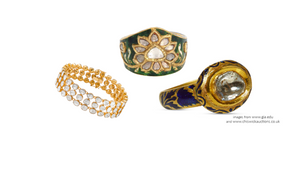What are Polki Diamonds?
Polki diamonds are one of the oldest forms of cut diamonds. The stone often retains its original rough form, but with a polished surface. The method originated in India and is still done there today.
There are Three Grades of Polki:
- Syndicate: The term “Syndicate” used to refer to material coming from De Beers, but the industry now uses the term to refer to the best grade of Polki.
- Zimbabwe: The term is for materials coming from the Zimbabwean mines in Africa.
- Khilwas: is the lowest grade.
As I explained in this blog post, there are four factors when grading a faceted diamond. For Polki diamonds there are three factors.
1. Color: Color is the most important consideration when choosing a Polki diamond. They tend to be brownish or yellowish. The polki diamonds with the least amount of color are highly valued and cost more.
2. Clarity: Clarity refers to the ratio of inclusions in a diamond. Since Polki diamonds are not faceted, the inclusions are often more noticeable. The fewer the inclusions, the more valuable the diamond. Clarity is even more important than the weight of the diamond.
3. Treatment: Sometimes, Polki diamonds are treated to enhance their appearance. A small amount of filler is inserted into the stone to improve the clarity and color.
These raw, rustic diamonds look very much like tumbled stones and can be set in gorgeous and interesting ways. The contrast of the raw stones and glimmering gold create works of art.
Want to read about other stone shapes and cutting? Read about cabochons here.


